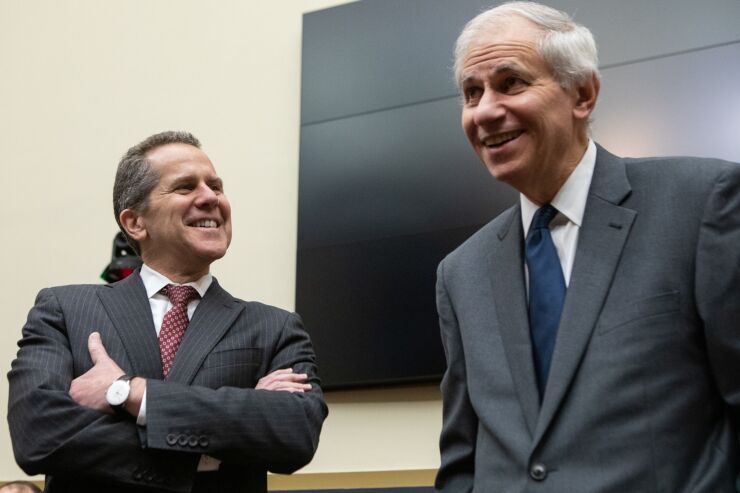
Federal regulators say there are new opportunities for banks in their
Federal Deposit Insurance Corp. Chair Martin Gruenberg, Acting Comptroller of the Currency Michael Hsu and Federal Reserve Vice Chair for Supervision Michael Barr
During the event, the nation's top bank cops noted that certain provisions of the revised CRA framework apply new levels of flexibility. This includes the ability to earn credit for non-traditional banking services — such as backing job training and workforce development initiatives — and the ability to get CRA credit for community development activities undertaken anywhere in the country.
They also pointed to new quantitative methods for assessing compliance with the rules and the establishment of a more open dialogue about what novel activities might be eligible for credit.
"One of the things this rule does is set out a set of illustrative practices that are going to be eligible for CRA consideration and also provides a process that can confirm somebody who's unsure about whether something counts or doesn't count," Barr said. "They can come ask us and we'll say 'Yeah, that's that's good. That counts for CRA,' and share that with others."
Gruenberg said the flexibility in the new rule will accommodate all types of business models in banking, including novel ones that have yet to surface. He added that he believes banks have responded well to these elements of the reform.
"The general reaction we've received is quite positive. Certainly from the community organizations and civil rights groups, but I think initial feedback from the banking community, I think, has been fairly positive," he said. "Although I want to give them some opportunity to work their way through it."
In the wake of the rule's finalization last week, banking trade groups issued a variety of statements. Some thanked the regulators for modernizing the implementation of the 46-year-old law, while others said they still needed to comb through the 1,500-page document to determine their support.

Some banks, meanwhile, raised pointed issues with the finalized rule. In particular, the threshold for being considered a "large bank" for CRA purposes being set at $2 billion of assets drew the ire of small banks and their allies. For most supervisory standards, banks with $10 billion of assets or less are considered community banks and are thus shielded from many obligations.
In a statement, the Independent Community Bankers of America, a trade group for small and mid-sized banks, said the package holds some beneficial changes for its members, but would overall saddle them with outsized compliance costs.
"By classifying all banks over $2 billion in assets as large banks, we are very concerned that the rule does not sufficiently differentiate between community banks and the nation's largest banks," ICBA President and CEO Rebeca Romero Rainey said in the statement.
The final rule also drew objections from Fed Gov. Michelle Bowman, the designated community banking member on the Board of Governors, as well as FDIC Directors Jonathan McKernan and Travis Hill. In their dissenting statements, the officials noted that the rule could exceed the statutory limitations of the CRA.
Enacted in 1977, the CRA requires banks to extend credit, investments and services to all communities within its service area, a mandate that has traditionally been tied to physical branch locations. One of the key goals of the reform effort — which has gone through fits and starts
But, McKernan said it was not clear to him that the law allows for such an expansion.
"I have not seen a convincing argument that we have the authority to consider lending activities outside a bank's facility-based assessment areas," he said before voting against the rule.
Legal and policy analysts say banks could have grounds for
Hsu acknowledged some of the criticisms that have emerged about the rule since its finalization, specifically pointing to the common refrain that it is too long. But, he noted that the level of detail included in the rule was intended to bring more clarity, which he believes will bear out overtime.
Hsu added that as he and his fellow regulators hammered out the details of the reform package, their intent was not just to make the CRA more modern but also stronger, which he said was characterized by
"There has to be just more activity, it has to be better targeted to the communities and it should be faster," Hsu said. "Certainty was sometimes hanging things up, particularly on community development activities, either from the banks or from community groups. Does it qualify? Does it not qualify? And one of the things that we did in the rule was to provide a bit more clarity and confidence on that."
While the bulk of the work on CRA is finished, regulators still must adopt the reforms individually. This process will include each agency training its examiners on the new framework, compiling its own handbook for it and developing related tools, which Barr said could include a public accessible dashboard on relevant activities.
Barr noted that it will take close cooperation between the three groups to ensure their approaches are aligned, but the agencies are committed to doing so.
"We are 100% committed to working together on implementation," Barr said. "We already are looking ahead to implementation and working together. We're going to stay tightly joined at the hip, not only on the process for saying what activities are eligible in the future, but all the hard work that's required."





